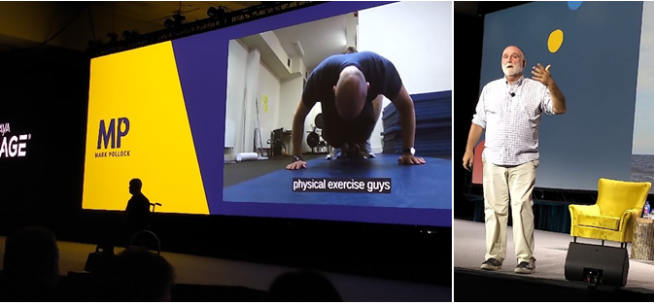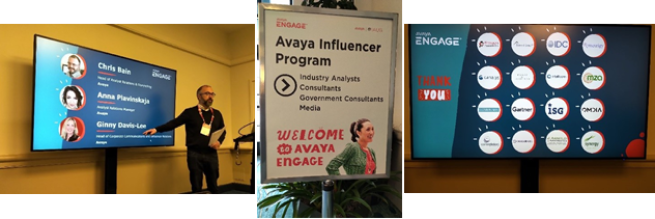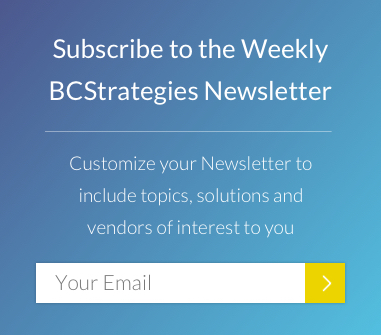
Avaya ENGAGE – Takeaways for Act III
No company in our space has had more drama than Avaya, since well, Nortel. At times that comparison seemed apt, but they diverge when strong leadership and sound strategy enter the picture. There’s a big difference between where Avaya is today and their second encounter with Chapter 11. That difference largely boils down to those two factors, and they were front and center during last week’s ENGAGE event in Orlando. I can’t think of another vendor that has emerged twice from Chapter 11, and with that in the rear-view mirror, Act III looks promising. With those two factors in mind, here are the takeaways that lead me to that conclusion.
Factor 1 – Strong Leadership
There’s a lot to like about CEO Alan Masarek, and I’ve long said he’s the right man for the job. In short order, he’s put a lot of the baggage that has weighed the company down in the past, and what remains is a strong culture, a rich pedigree, solid financials, and an unrivalled customer base. As Alan likes to say, he likes the cards he’s holding – maybe not a full house, but a straight for sure, and maybe a flush. I’ll take that too. He personifies the confidence that is easy to get behind – “Avaya’s back!” – and more defiantly “we are decidedly undead.” Good words to rally around, but there’s substance behind that. Here are three things that struck me along those lines.
1. Leadership mantra
Right off the top, Alan laid out Avaya’s leadership tenets – “open, honest, direct and transparent.” These may sound like motherhood – and they seem to be table stakes in 2023 – but it’s more or less the inverse of what came before at Avaya. That inverse was, in fact, what put the company into a near-death spiral, and that’s where the uncomfortable Nortel parallels start popping up. Today, though, this sounds like a pretty good fresh start, and for Avaya to win back trust – from customers, partners, and investors – this really is table stakes.
2. Innovation without disruption
Simple words, but a strong value proposition that should resonate with Avaya’s base. Good leadership means knowing what’s important to your customers and delivering on that. Avaya isn’t forcing customers to the cloud, and nor are they abandoning premises-based customers – much like what some others have been doing.
The messaging from Alan and his team is to serve the base well, and that means keeping the on-prem base in order, but also delivering cloud-based capabilities on top of that to enable innovation. Many customers are not willing or able – or both – to make a wholesale shift to the cloud – that’s the disruption – but they also need the innovation that these systems cannot inherently provide. Avaya is trying to give them the best of both worlds.
Late to the cloud, but…
Another good quality in leaders is recognizing shortcomings, but also shifting to where the opportunities lie. Everyone knows Avaya was late with cloud, and it almost sunk them. It’s one thing to act as if it’s not a factor and expect to remain competitive, but another to acknowledge that and adapt to what’s in front of you. In hindsight, Alan is able to do the latter, especially since that was not his doing.
More importantly, though, he framed this in a bigger picture. Cloud isn’t the only technology wave that is transforming everything. That’s very 2020, but right now, AI is the next wave, and Alan rightly notes that it’s going to be even more transformative. Timing is everything, and they survived being late to cloud. With AI, though, it’s early in the game, and they can be very competitive here. That’s the bigger opportunity now, especially since cloud is now dominated by four players, and Avaya was never going to catch them on that front.
Factor 2 – Sound Strategy and Execution
Good leadership begets sound strategy, and I saw three good examples of where that strategy seems to be paying off. Before getting to those, I should note a common thread that wasn’t really stated explicitly – namely, that the premises-based market remains large. It’s not just Avaya, though – we heard that at Enterprise Connect, and I’ve certainly heard it at other recent analyst events. There’s plenty of action around cloud-only deployments and cloud-native vendors, but for vendors with long histories rooted in legacy telephony, many of their customers have a long way before getting to that point.
Strategy success 1 – customer chooses their journey
I should first say that in terms of portfolio, contact center is now the main focus. Avaya Experience Platform (AXP) envelops most of the portfolio, which mainly supports legacy contact centers as well as UCaaS and voice. The taxonomy for all these pieces requires a separate post, including where Avaya Cloud Office (ACO) sits for UCaaS-only customers in partnership with RingCentral. Even after two days, it’s a lot to digest, and for now, I’ll stick to the strategy.
On that front, the main message is that Avaya has options for whatever form or path premises-based customers want to take to the cloud – “my Avaya journey.” That’s a very customer-centric approach, and it seems to be working. They brought out several customers to tell their story, and they were all pretty compelling.
The best for me was Liberty Mutual, simply because insurance is very much a commodity where differentiation is hard to do. Well, they chose to differentiate on customer service, where adding cloud gave them new features to meet customers where they are. Many others, of course, are doing that now as well, but what stood out to me was how they’ve shifted so much to using digital channels to engage with customers that they no longer include a toll-free number on their advertising. That could only have happened by making a move to the cloud.
Strategy success 2 – reinvigorate the channel
Over the course of various sessions, we heard how Avaya is taking a more modern approach to working with partners. Rather than just using sales targets as success metrics, they’re taking a more holistic approach to train them and help them engage with end customers to build better long-term relationships.
The financial performance still needs to be there, but Avaya needs partners who can understand and get behind their portfolio strategy. They talked about six different types of partners, including BPOs, which they view as being very promising for them.
In terms of results, we heard that in the last six months, they have flipped 15% of “decliner” partners into “growers.” With all the uncertainty about Avaya’s future, it’s understandable why there would be “decliner” partners, and that 15% flip indicates that some like what they see from Alan and the new game plan. We also heard that they expect that level to grow to 30% as Avaya’s performance continues improving. Time will tell, but the early signs are promising.
For clarity, we did not get any granularity on those numbers, so it’s hard to know how much net impact this flipping is actually having. The same goes for broader growth metrics that were shared – over the past 12 months, they’ve added 3,000 new customers and 400,000 new seats. In absolute terms these sound great, but I don’t know what the other side of the ledger is –churn, lost seats, lost customers, etc. – making it hard to pin down how much net new growth is truly happening.
Strategy success 3 – marketing do-over
Remember, “Avaya is back.” I’m a marketing guy, so Kim Howland’s messaging was of particular interest. Marketing is critical in terms of conveying the kind of messaging to back that claim up and convince the market that Avaya is indeed back. Alan certainly understands that, and Kim shared with us how they upped investment in branding. This is part of good strategy, where Act III requires everyone to be in their places, and marketing plays a leading role.
Not only does the branding need to reflect the new Avaya, but it needs to stand out in a very crowded market. There are plenty of other contact center vendors with comparable technology, and too many vendors in the UC space, and Kim noted a sameness for how they convey their messaging. Good branding starts with seeing what everyone else is doing and making damn sure you don’t do what they’re doing.
Without getting into detail, Kim walked us through the various ways they’re trying to stand out, and overall, I think it’s pretty effective; ranging from the typeface, imagery, color, and clean layouts. More important is the need for this to tie into the bigger picture and reflect the strategy Alan has set the entire company on course for. Seems to me that across the board, he’s got everyone on the same page; if they all play their parts, I think Act III could go on for quite a while.
What About the Photos?
I posted many of my photos throughout the event on social media, and I’ll share a few here for a sense of the vibe in Orlando. Feel free to share, but if you do, please provide attribution, thanks.

During the analyst breakouts – Alan Masarek, Tim Sherwood, and Kirk Jones
What’s better than one inspirational speaker? How about two? We heard from Mark Pollock and Jose Andres – each was great, and each talked how anything is possible if you think big, believe in yourself, and believe in others. Sounds like Avaya’s Act III, right?

Finally, thanks much to Avaya’s Analyst Relations team, who did a great job pulling all this together for us!

Tags
Start YourCustomized Search
SOLUTION AREA
SOLUTION PROVIDERS
- 8x8 (40) Apply 8x8 filter
- Alcatel-Lucent Enterprise (50) Apply Alcatel-Lucent Enterprise filter
- AT&T (44) Apply AT&T filter
- AudioCodes (49) Apply AudioCodes filter
- Avaya (397) Apply Avaya filter
- Cisco (574) Apply Cisco filter
- Dell (11) Apply Dell filter
- Five9 (54) Apply Five9 filter
- Fuze (39) Apply Fuze filter
- Genesys (100) Apply Genesys filter
- HP (98) Apply HP filter
- IBM (171) Apply IBM filter
- Jabra (9) Apply Jabra filter
- Logitech (56) Apply Logitech filter
- Lumen (4) Apply Lumen filter
- Masergy (50) Apply Masergy filter
- Microsoft (766) Apply Microsoft filter
- Mitel (233) Apply Mitel filter
- NEC (128) Apply NEC filter
- Nectar (58) Apply Nectar filter
- Polycom (95) Apply Polycom filter
- Ramp (37) Apply Ramp filter
- RingCentral (126) Apply RingCentral filter
- Sennheiser (18) Apply Sennheiser filter
- Slack (13) Apply Slack filter
- Tata Communications (59) Apply Tata Communications filter
- Unify (186) Apply Unify filter
- Vonage Business (80) Apply Vonage Business filter
- Yealink (8) Apply Yealink filter
- Zoom (21) Apply Zoom filter
- Acme Packet (24) Apply Acme Packet filter
- Allworx (2) Apply Allworx filter
- Arkadin (22) Apply Arkadin filter
- Aspect (34) Apply Aspect filter
- BT (25) Apply BT filter
- CaféX (8) Apply CaféX filter
- CallTower (14) Apply CallTower filter
- Clarity Connect (10) Apply Clarity Connect filter
- Continuant (1) Apply Continuant filter
- Damaka (4) Apply Damaka filter
- Dialogic (5) Apply Dialogic filter
- Dimension Data (44) Apply Dimension Data filter
- Empirix (11) Apply Empirix filter
- Enghouse Interactive (17) Apply Enghouse Interactive filter
- Inference Solutions (9) Apply Inference Solutions filter
- IntelePeer (27) Apply IntelePeer filter
- IR (11) Apply IR filter
- Jive (21) Apply Jive filter
- Kurmi Software (21) Apply Kurmi Software filter
- Lifesize (33) Apply Lifesize filter
- Lightware (3) Apply Lightware filter
- Mavenir (6) Apply Mavenir filter
- Modality Systems (8) Apply Modality Systems filter
- Momentum (36) Apply Momentum filter
- Netfortris (5) Apply Netfortris filter
- NetSapiens (6) Apply NetSapiens filter
- NewVoiceMedia (31) Apply NewVoiceMedia filter
- Nureva (26) Apply Nureva filter
- NUWAVE (5) Apply NUWAVE filter
- Orange (32) Apply Orange filter
- OVCC (8) Apply OVCC filter
- Panasonic (18) Apply Panasonic filter
- PanTerra Networks (9) Apply PanTerra Networks filter
- ScanSource (21) Apply ScanSource filter
- SIPPIO (3) Apply SIPPIO filter
- Snom (20) Apply Snom filter
- Star2Star (8) Apply Star2Star filter
- StarLeaf (12) Apply StarLeaf filter
- Tadiran Telecom (2) Apply Tadiran Telecom filter
- TekVizion (9) Apply TekVizion filter
- Unimax (7) Apply Unimax filter
- Verint (41) Apply Verint filter
- Voice4Net (2) Apply Voice4Net filter
- VOSS (85) Apply VOSS filter
- Voxbone (14) Apply Voxbone filter
- West (28) Apply West filter
- XO Communications (3) Apply XO Communications filter
- Yorktel (17) Apply Yorktel filter
- Zultys (2) Apply Zultys filter
- 3CX (8) Apply 3CX filter
- ADDASOUND (1) Apply ADDASOUND filter
- Aerohive (1) Apply Aerohive filter
- Aryaka (1) Apply Aryaka filter
- Asurion (22) Apply Asurion filter
- Avnet (7) Apply Avnet filter
- Bandwidth (5) Apply Bandwidth filter
- Calabrio (5) Apply Calabrio filter
- Consilium Software (13) Apply Consilium Software filter
- Drum (5) Apply Drum filter
- ESI (6) Apply ESI filter
- Esna (16) Apply Esna filter
- Exinda (2) Apply Exinda filter
- EZuce (3) Apply EZuce filter
- GUnify (6) Apply GUnify filter
- Highfive (4) Apply Highfive filter
- Huawei (47) Apply Huawei filter
- Imagicle (3) Apply Imagicle filter
- IPCortex (1) Apply IPCortex filter
- KnoahSoft (1) Apply KnoahSoft filter
- KOVA (1) Apply KOVA filter
- Logmein (9) Apply Logmein filter
- Metropolis Technologies (4) Apply Metropolis Technologies filter
- Mutare (2) Apply Mutare filter
- NextPlane (27) Apply NextPlane filter
- Ooma (16) Apply Ooma filter
- Patton (11) Apply Patton filter
- Radish Systems (1) Apply Radish Systems filter
- Radisys (3) Apply Radisys filter
- Shango (1) Apply Shango filter
- SMART (163) Apply SMART filter
- Stack8 (1) Apply Stack8 filter
- Swyx (1) Apply Swyx filter
- TrueConf (4) Apply TrueConf filter
- UJET (13) Apply UJET filter
- Voximplant (3) Apply Voximplant filter
CONTENT TYPE
- BC Expert Insights Market (43) Apply BC Expert Insights Market filter
- BC Expert Insights Objective - Vendor Neutral (42) Apply BC Expert Insights Objective - Vendor Neutral filter
- BC Expert Insights Planning (15) Apply BC Expert Insights Planning filter
- BC Expert Insights Solution (12) Apply BC Expert Insights Solution filter
- BC Expert Insights Vendor (80) Apply BC Expert Insights Vendor filter
- BC Expert Insights Vendor Solution (145) Apply BC Expert Insights Vendor Solution filter
- BC Expert Roundtable (133) Apply BC Expert Roundtable filter
- Bcs Webinar (0)
- Bcs Webinar Registration (0)
- Best Practice (38) Apply Best Practice filter
- Buyer Guide (14) Apply Buyer Guide filter
- Case Study (29) Apply Case Study filter
- Executive Interview (145) Apply Executive Interview filter
- Expert Roundtable (450) Apply Expert Roundtable filter
- Guest Contributions (35) Apply Guest Contributions filter
- Multimedia (38) Apply Multimedia filter
- News Analysis (2081) Apply News Analysis filter
- Newsfeed Article (1303) Apply Newsfeed Article filter
- Newsfeed Article (1) Apply Newsfeed Article filter
- Thought Leadership (21) Apply Thought Leadership filter
- Vendor Collateral (211) Apply Vendor Collateral filter
- Vendor Resource Best Practices (24) Apply Vendor Resource Best Practices filter
- Vendor Resource Buyers Guides (2) Apply Vendor Resource Buyers Guides filter
- Vendor Resource Multimedia Content (4) Apply Vendor Resource Multimedia Content filter
- Vendor Resource White Paper (4) Apply Vendor Resource White Paper filter
- Webinar (13) Apply Webinar filter
- Webinars (7) Apply Webinars filter
- White Paper (64) Apply White Paper filter
MORE FILTERS
INDUSTRY
- Banking And Investment (800) Apply Banking And Investment filter
- Education (446) Apply Education filter
- Energy And Utilities (487) Apply Energy And Utilities filter
- Finance (12) Apply Finance filter
- Government (675) Apply Government filter
- Healthcare (482) Apply Healthcare filter
- Hospitality (180) Apply Hospitality filter
- Insurance (100) Apply Insurance filter
- Manufacturing (704) Apply Manufacturing filter
- Media/Publishing (422) Apply Media/Publishing filter
- None (43) Apply None filter
- Professional Services (745) Apply Professional Services filter
- Retail & Distribution (798) Apply Retail & Distribution filter
- Technology (1611) Apply Technology filter
- Transportation (110) Apply Transportation filter
PUBLICATION DATE
Latest Articles
Latest Articles

































































































































































Comments
There are currently no comments on this article.
You must be a registered user to make comments
Add new comment